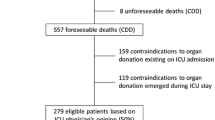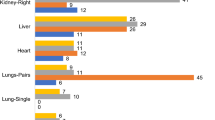Abstract.
The increasing demand for organs for transplantation entails a consensual need for enhancement of organ procurement activity. As organ donors reside mainly in hospital intensive care units (ICUs), the Donor Action programme is aimed at identifying critical areas in ICUs, in order to improve the first step of organ donation. The purpose of this paper is to analyse the problem of identification of potential donors by means of a chart revision of patients who died in 14 ICUs in the Emilia-Romagna region between 1 July 1998 and 31 December 2000. All deaths and patients with severe brain insult (score on Glasgow Coma Scale (GCS) = 3/15) were assessed by the local transplant co-ordinators together with a professional at the Transplant Reference Centre. Brain death diagnoses and potential donor referrals were therefore assessed in the study period, which was subdivided into five semesters. Of the 3,056 deaths reported in 30 months, 1,248 were due to severe brain damage (GCS score = 3). Brain death diagnosis (BD) was performed in 509 patients (40.8%). Although we applied the same parameters over the whole length of the study, we observed a significant increase in BDs (from 87 in the first semester to 125 in the last, 30.5% to 53.0% of the patients with GCS 3 (P=0.003, χ2 for trend=16.072), in spite of a slight decrease in the total number of deaths and in the total number of patients with GCS score = 3 (from 649 to 587, and from 44% to 41%, respectively). Study population characteristics could have contrasted with rather than facilitated our results: age and gender did not change significantly, whilst cause of death showed a significant reduction in trauma and an increase in cerebrovascular incidents over the whole length of the study. We can conclude that the more careful assessment of patients dying in ICUs, by the Donor Action programme, significantly contributed to the improvement of BDs observed in the study period. Therefore, Donor Action seems to be an efficient quality control programme to improve identification of potential donors, the first stage of organ procurement.
Similar content being viewed by others
References
Ad Hoc Committee of the Harvard Medical School to examine the definition of brain death (1968) A definition of irreversible coma (report). JAMA 205:337–340
Alonso M, Fernández M, Mataix R, Rincón MD, Corrales JA, Burgos R, Miranda B (1999) Donor Action in Spain: a program to increase organ donation. Transplant Proc 31:1084–1085
Botia E, Vivancos J, Leon T, Segua T, Fernandez-Garcia C, Lopez-Lopez F (1996) Predictive mortality factors and the development of major complications in nontraumatic subarachnoid hemorrhage. Rev Neurol 24:193–198
Cohen B, Wight CA (1999) European perspective on organ procurement: breaking down the barriers to organ donation. Transplantation 68:985–990
Diethelm AG, Deierhoi MH, Hudson SL, Laskow DA, Julian BA, Gaston RS, Bynon JS, Curtis JJ (1995) Progress in renal transplantation, a single center study of 3359 patients over 25 years. Ann Surg 221:446–458
Espinel E, Deulofeu R, Sabater R, Manyalich M, Domingo P, Rue M (1989) The capacity for organ generation of hospitals in Catalonia, Spain; a multicentre study. Transplant Proc 21:1419–1421
Goulon M, Nouailhat F, Babinet P (1971) Irreversible coma. Ann Med Interne 122:479–486
Hamel MB, Goldman L, Teno J, Lynn J, Davis RB, Harrell FE Jr., Connors AF Jr, Califf R, Kussin P, Belamy P (1995) Identification of comatose patients at high risk for death or severe disability. JAMA 273:1842–1848
Hamilton D (1994) Kidney transplantation: a history. In: Morris P (ed) Kidney transplantation, principles and practices. Saunders, Philadelphia, pp 1–7
Hung TP, Chen ST (1995) Prognosis of deeply comatose patients on ventilators. J Neurol Neurosurg Psychiatry 58:75–80
López-Navidad A, Domingo P, Viedma MA (1997) Professional characteristics of the transplant coordinator. Transplant Proc 29:1607–1613
Matesanz R, Alonso M, Fernández LM, Miranda B (1996) Spanish model to improve organ donation: the hospital transplant coordinator. Transplant Proc 28:3359
Mollaret P, Pierre-Bourgeois, Amie C, Bonnet JL, Clement D, Vic-Dupont V, Duprey J, Fournier E, Garaix JP, Goulon M, Pocidalo JJ, Rapin M (1967) Round table on the indications and limits in medical resuscitation. Cah Coll Med Hop Paris 8:455–486
Powner DJ, Snyder JV, Grenvik A (1977) Brain death certification. A review. Crit Care Med 5:230–233
Rapenne T, Lenfant F, N'Guyen Kim L, Honnart D, Beaurain J, Freysz M (1997) Predictive factors of short-term mortality in patients with severe head injury. Presse Med 26:1661–1665
Roels L, Wight C (2001) Donor Action: an international initiative to alleviate organ shortage. Prog Transplant 11:90–97
Setzer NA (1996) Brain death in children. In: Rogers MC (ed) Textbook of pediatric intensive care. Lippincott, Williams & Wilkins, Baltimore, USA, pp 741–752
The Task Force on Death and Dying of the Institute of Society, Ethics and the Life Sciences (1972) Refinements in criteria for the determination of death: an appraisal (report). JAMA 221:48–53
Venturoli N, Venturi S, Taddei S, Ridolfi L, Pugliese MR, Petrini F, Monti M, Nanni Costa A, Martinelli G (2000) Organ donation and transplantation as health programs in Italy. Prog Transplant 10:60–64
Wight C, Roels L (1996) Donor Action: an international initiative to improve organ donation rates. Eurotransplant Newsletter 132:15–16
Wight C, Cohen B, Roels L, Miranda B (2000) Donor Action: a quality assurance program for intensive care units that increases organ donation. Eur J Intensive Care Med 15:104–114
Acknowledgements.
We are grateful to the staff of the 14 intensive care units who collaborated with the registration of the charts in this study: Dr. A. Pigna, Sant'Orsola Hospital, Bologna; Drs. C. Festa, G. Gambale, Maggiore Hospital, Bologna; Drs. M. Zanello, M. Neri, Bellaria Hospital, Bologna; Dr. R. Foppoli, Carpi Hospital; Drs. S. Bucci, F. Cocciolo, G. Pugliese, Cesena Hospital; Dr. P. Casalini, Faenza Hospital; Dr. G. Mantovani, Ferrara Hospital; Dr. P. Gudenzi, Forlì Hospital; Drs. C. Vaccari, D. Iseppi, Modena Hospital; Dr. M. Mergoni, Parma Hospital; Dr. A. Garelli, Ravenna Hospital; Drs. L. Favilli, M. Salsi, Reggio Emilia Hospital; Drs. A. Corsi, F. Bruscoli, Rimini Hospital.
Author information
Authors and Affiliations
Corresponding author
About this article
Cite this article
Pugliese, M.R., Degli Esposti, D., Dormi, A. et al. Improving donor identification with the Donor Action programme. Transpl Int 16, 21–25 (2003). https://doi.org/10.1007/s00147-002-0497-7
Received:
Revised:
Accepted:
Published:
Issue Date:
DOI: https://doi.org/10.1007/s00147-002-0497-7




